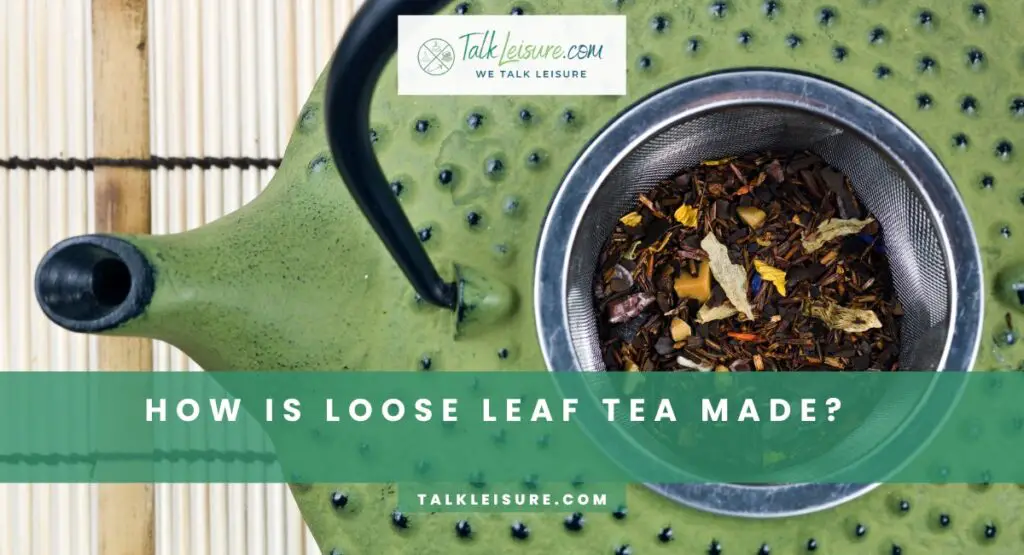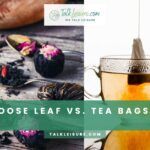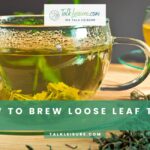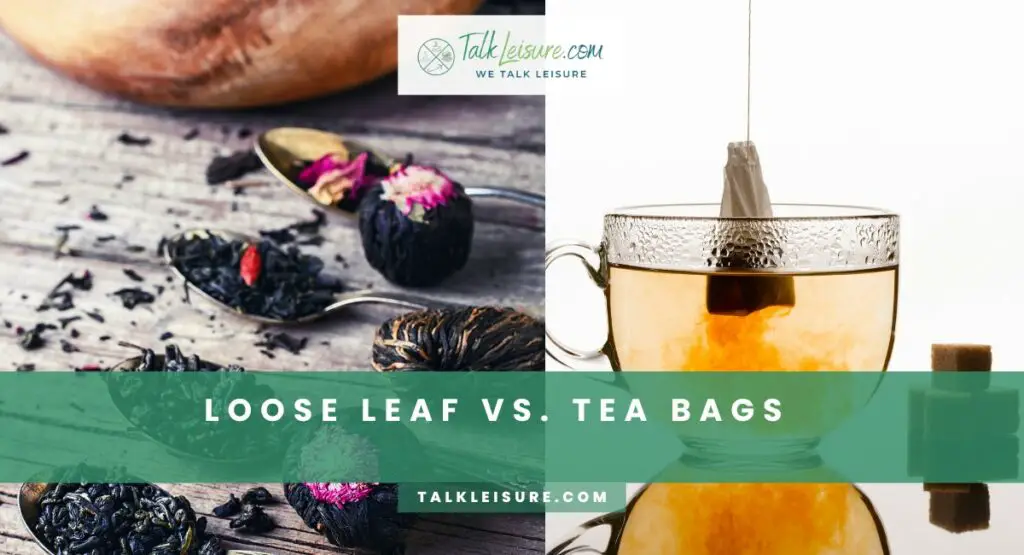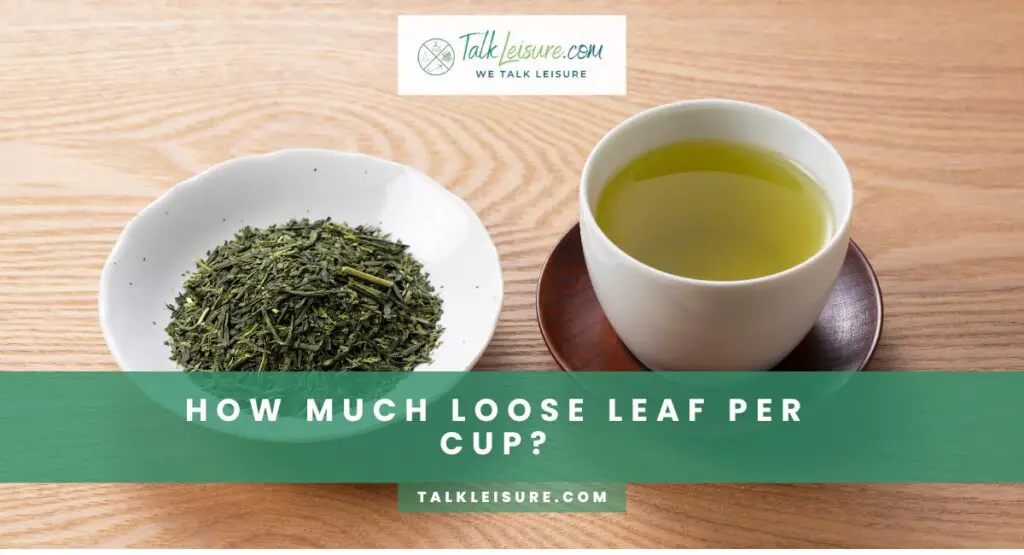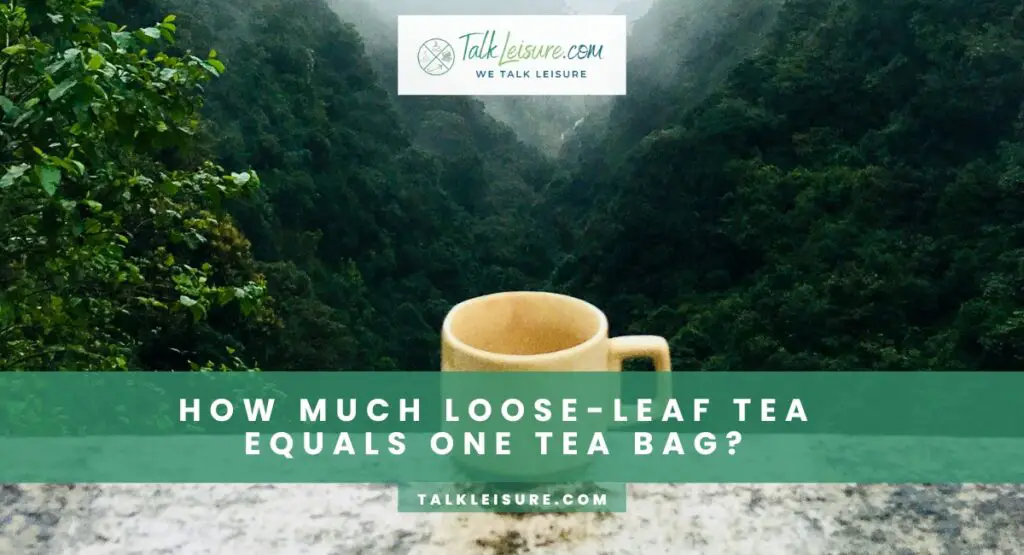Tea, a beverage cherished worldwide for its comforting taste and potential health benefits, comes in various forms and flavors.
One of the most popular and traditional ways to enjoy tea is through loose-leaf tea.
Unlike tea bags containing finely ground tea leaves, loose-leaf tea consists of whole or fragmented leaves that offer a richer and more nuanced flavor profile.
Loose-leaf tea is made by plucking whole tea leaves from the tea plant, allowing them to wither, then rolling and shaping them to release enzymes. Leaves are oxidized or heated, dried, and sorted to create various types like green, black, or oolong tea.
This article delves into how loose-leaf tea is made, from cultivating tea plants to brewing the perfect cup.
What Is Loose Leaf Tea?

Loose-leaf tea is a type of tea that is not packed into tea bags. Instead, it’s sold naturally as whole or broken tea leaves.
When you brew loose-leaf tea, you use the leaves directly in hot water, allowing the flavors and aromas to infuse more fully.
It’s like making tea from scratch! Loose-leaf tea, like black, green, oolong, or herbal, often comes in various types with unique tastes and benefits.
You’ll need a tea infuser or a teapot with a built-in strainer to make a cup. Many people enjoy loose-leaf tea for its fresher taste and ritualistic preparation.
It’s a delightful way to explore the world of tea and savor its natural goodness.
How Is Loose Leaf Tea Processed?
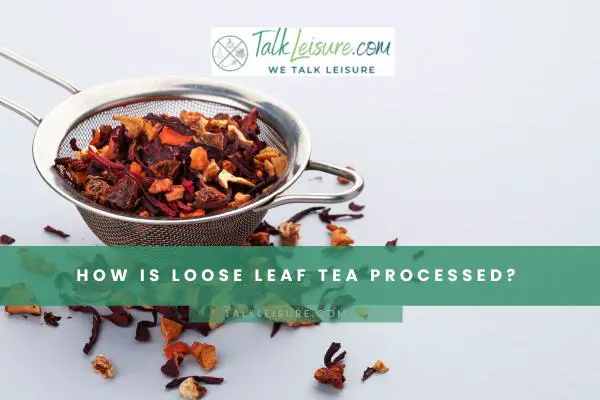
The journey of loose-leaf tea from the tea plant to your cup involves several intricate steps. These steps can vary depending on the tea type, whether black, green, oolong, or white.
I’d happily explain how loose-leaf tea is processed in simple terms!
Plucking: The first step in making loose-leaf tea is plucking the tea leaves from the tea plant. Skilled workers carefully pick the young and tender leaves and buds. These are the best parts of making tea.
Withering: After plucking, the leaves are spread out to dry in a cool, breezy area. This is called withering. It helps remove excess moisture from the leaves, making them more flexible for the next steps.
Rolling: The withered leaves are gently rolled, sometimes by hand or machine. This breaks the cell walls inside the leaves and starts the oxidation process. Oxidation is what gives different types of tea their distinct flavors.
Oxidation: Depending on the type of tea being made, the leaves are left to oxidize for a certain amount of time. Black tea is fully oxidized, while green tea is minimally oxidized. Oxidation changes the color, aroma, and flavor of the leaves.
Firing or Steaming: The leaves are heated quickly to stop oxidation. For green tea, this is often done by steaming. Black tea is usually made by firing the leaves in an oven or a pan. This helps “lock in” the flavor and color created during oxidation.
Sorting: The now-dry leaves are sorted based on size and quality. Broken leaves might be used for lower-grade teas, while whole leaves are used for higher-quality teas.
Packaging: After sorting, the tea is packaged as loose leaves. It’s not put into tea bags yet. This way, you can see and appreciate the whole leaves’ beauty.
Enjoying: To make a cup of tea, you’ll take a small amount of the loose tea leaves and steep them in hot water. This allows the flavors and aromas to infuse into the water, creating your tasty cup of tea!
So, in a nutshell, loose-leaf tea goes through plucking, withering, rolling, oxidation, firing/steaming, sorting, and then it’s ready for you to enjoy a flavorful cup of tea.
Let’s explore the general process of making loose-leaf tea in a factory:
Process Of Making Tea In A Factory
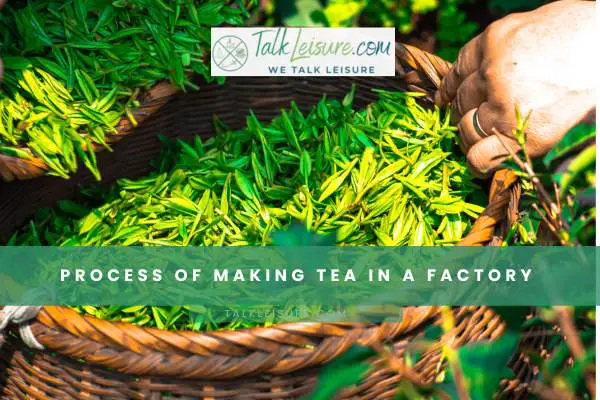
Cultivation Of Tea Plant: Loose-leaf tea begins with the cultivation of the Camellia sinensis plant. These plants thrive in specific climates and altitudes, contributing to the final tea’s distinctive qualities.
Processing Of Tea Leaves:
- Withering: After harvesting, the tea leaves are spread out in a controlled environment to wither. This step reduces moisture content and makes the leaves more pliable for subsequent processing.
- Rolling: The withered leaves are rolled to break their cell walls and initiate oxidation. This step is crucial for the development of flavor and aroma.
- Oxidation: Oxidation is carefully controlled Depending on the tea being produced. Green tea is minimally oxidized, while black tea undergoes complete oxidation. Oolong tea falls in between, with partial oxidation.
- Drying: The oxidized leaves are dried to halt the oxidation process. This step ensures that the leaves are stable for storage and consumption.
How Tea Is Made: Production Process Explained
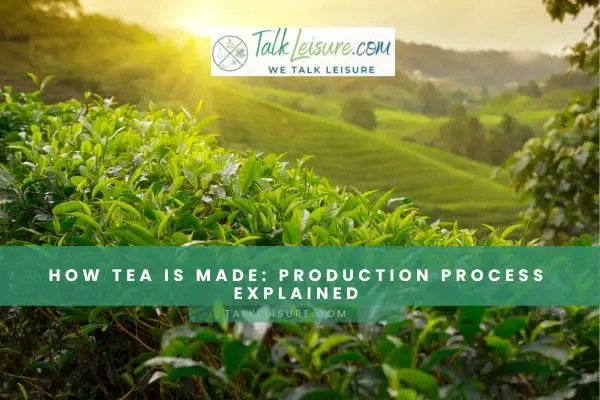
The production process of tea involves a delicate balance of art and science.
Each step contributes to the unique characteristics of the final product. Let’s delve deeper into the individual stages of tea processing:
Cultivation Of Tea Plant
Tea plants require specific conditions to thrive.
They are typically grown in regions with moderate temperatures, high humidity, and well-draining soil. The altitude at which the tea plants are grown also plays a role in the flavor and quality of the tea leaves.
The leaves used for loose-leaf tea are usually plucked from the top two leaves and a bud, as they offer the best flavor and aroma.
Processing Of Tea Leaves
Withering
After plucking, the leaves are spread out on withering racks or trays. The controlled environment allows air circulation and gradual moisture reduction. This step makes the leaves supple and prepares them for rolling.
Rolling
Rolling is a mechanical process that breaks the cell walls of the tea leaves. This releases enzymes that trigger oxidation. The rolling can be done by hand or using machines, and the extent of rolling determines the final shape and appearance of the tea leaves.
Oxidation
Oxidation is a crucial step that greatly influences the flavor and color of the tea. During oxidation, enzymes in the leaves interact with oxygen in the air. This process is carefully monitored and controlled. Green tea is minimally oxidized, preserving its natural green color and grassy taste. Oolong tea undergoes partial oxidation, resulting in diverse flavors, while black tea is fully oxidized, giving it a bold and robust taste.
Drying
To halt oxidation, the leaves are dried. This step reduces the moisture content to prevent spoilage and microbial growth. The dried leaves are then sorted and graded based on size, appearance, and quality.
How To Make Loose Leaf Tea?

Making loose-leaf tea is an art that requires attention to detail and a sense of timing.
Preparing loose-leaf tea offers a delightful opportunity to engage in a sensory experience transcending the ordinary.
Unlike conventional tea bags, loose-leaf tea invites you to embark on a journey that tantalizes your taste buds and envelops you in a soothing aroma.
Regardless of whether you’re taking your first steps into the world of loose-leaf tea or if you’re a seasoned aficionado, mastering the art of loose-leaf tea-making holds the promise of not only a gratifying cup but also a profound connection with the intricacies of tea craftsmanship.
Within this guide’s pages, we will explore the step-by-step process and techniques to seamlessly brew a cup of loose-leaf tea that embodies various flavors and fragrances, ultimately elevating your tea-drinking escapades to unparalleled dimensions.
Here’s how you can make a perfect cup of loose-leaf tea:
How To Make Loose Leaf Tea On The Stove?
- Boil Water: Heat fresh, filtered water to the appropriate temperature for the type of tea you’re brewing. Different teas require different water temperatures for optimal flavor extraction.
- Measure Tea: Measure the appropriate amount of loose-leaf tea. A general guideline is one teaspoon of tea per 8 ounces of water.
- Warm Teapot: Pour a small amount of hot water into the teapot. Then, pour out the water.
- Add Tea: Place the measured tea leaves into the teapot.
- Pour Water: Pour the heated water over the tea leaves.
- Steep: Allow the tea to steep for the recommended time. This varies based on the type of tea and personal preference.
- Strain and Enjoy: Use a fine-mesh strainer or an infuser to strain the tea into cups. Enjoy it plain or with added sweeteners, milk, or lemon, according to your taste.
How To Brew Loose Leaf Tea With An Infuser?
- Choose Infuser: Select a tea infuser that’s appropriate for your teapot or cup size.
- Measure Tea: Place the desired amount of loose-leaf tea into the infuser.
- Add Hot Water: Place the infuser with the tea into your teapot or cup.
- Pour Water: Pour hot water over the tea-filled infuser.
- Steep: Let the tea steep for the recommended time.
- Remove Infuser: Once the tea is steeped, remove the infuser to prevent over-steeping.
- Savor: Enjoy your freshly brewed loose-leaf tea.
How To Brew Loose Leaf Tea Without An Infuser?
- Measure Tea: Place the appropriate amount of loose-leaf tea directly into the teapot or cup.
- Boil Water: Heat water to the recommended temperature for the type of tea you’re brewing.
- Pour Water: Pour the hot water over the tea leaves.
- Stir and Steep: Give the tea leaves a gentle stir to ensure even steeping. Let the tea steep for the recommended time.
- Strain: A fine-mesh strainer separates the tea leaves from the liquid.
- Serve: Pour the strained tea into cups and enjoy.
How To Drink Loose Leaf Tea?

Drinking loose-leaf tea can be a delightful experience when done correctly. Here are a few tips to enhance your loose-leaf tea enjoyment:
- Savor the Aroma: Before taking a sip, inhale the aroma of the tea. The scent can provide hints about the flavor profile you’re about to experience.
- Appreciate the Flavor: Take small sips and let the tea linger on your palate. Pay attention to the various flavor notes that unfold.
- Experiment with Temperature and Steep Time: Adjusting the water temperature and steeping time can bring out different aspects of the tea’s flavor. Explore and find your preferred balance.
- Avoid Over-Steeping: Leaving the tea leaves in the water for too long can result in bitterness. Follow the recommended steeping times for optimal taste.
- Pair with Food: Loose-leaf teas can be paired with various foods to enhance the dining experience. Experiment with different combinations to find what suits your taste.
Final Thoughts
Loose-leaf tea is a cherished tradition that offers a sensory journey from the tea plant to your cup.
The meticulous cultivation, careful processing, and thoughtful brewing all contribute to the exquisite flavors and aromas that loose-leaf tea enthusiasts appreciate.
Whether you’re new to loose-leaf tea or a seasoned connoisseur, taking the time to understand the tea journey can deepen your appreciation for this timeless beverage.
The journey of loose-leaf tea from cultivation to cup is a harmonious blend of nature and human expertise.
Each step, from plucking to brewing, creates a sensory experience that has been cherished for centuries.
So, the next time you enjoy a cup of loose-leaf tea, take a moment to reflect on the intricate processes that have culminated in the comforting and invigorating beverage in your hands.
FAQ
Is Loose Leaf Tea Healthier Than Tea Bags?
Loose-leaf tea often contains larger, whole leaves that can retain more natural oils and flavor compounds than the smaller, broken leaves found in tea bags. This might result in a more robust flavor and potential health benefits.
How Do You Make Loose Leaf Tea From Scratch?
Making loose-leaf tea from scratch involves growing and harvesting tea plants, processing the leaves through withering, rolling, oxidation, and drying, and brewing the leaves to create the final beverage.
How Is Leaf Tea Made?
Leaf tea, including loose-leaf tea, is made through steps involving withering, rolling, oxidation, and drying tea leaves. These steps are crucial for developing the flavor and aroma of the tea.
Best Wishes!

